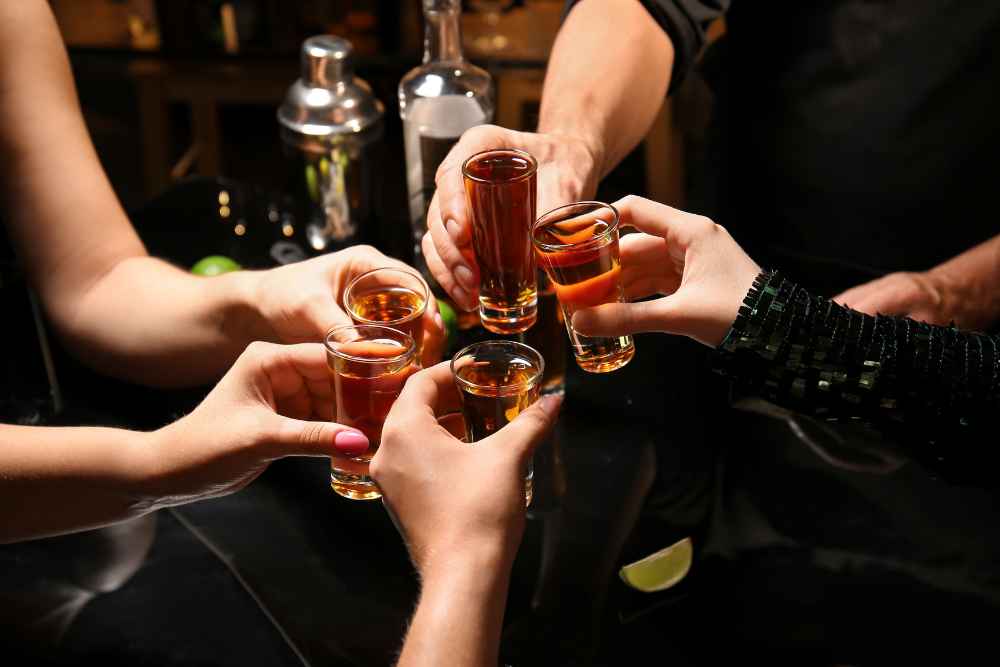This page may contain affiliate links. Please see our Disclaimer for more information. Always drink responsibly and adhere to your local legal drinking age.
Ever wondered how many shots it takes to feel that tipsy buzz? It’s a common question, and the answer is not as straightforward as you might think. This blog will dive deep into factors like weight, gender, metabolism, and type of alcohol, which all play a role in determining your level of intoxication.
Stick around to discover just how much liquor it usually takes to go from sober to drunk responsibly!
Key Takeaways:
- The number of shots it takes to get drunk can vary based on factors such as weight, gender, and metabolism.
- Women generally become intoxicated faster than men due to higher body fat percentages and slower alcohol metabolism.
- Body mass/weight is an important factor in alcohol absorption, with lighter individuals experiencing quicker and more potent effects.
- Genetics can play a role in how alcohol affects the body, with certain genetic variations making individuals more or less sensitive to its effects.
- The rate at which you consume alcohol can significantly impact how quickly you get drunk, so it’s essential to pace yourself when drinking.
- Mixing alcohol with medication or drugs can have serious consequences and increase the intoxicating effects of alcohol.
- Different types of alcoholic beverages have varying levels of alcohol content, so the number of shots required to get drunk differs for each type.
Understanding Alcohol and its Effects
Alcohol, a popular beverage choice worldwide, has various effects on the human body.
What is Alcohol?
Alcohol, commonly known as ethanol in the scientific community, is a psychoactive substance widely consumed across the globe. Derived from the fermentation of sugars by yeasts, it’s predominantly found in drinks like beer, wine, and spirits such as vodka, which typically contains around 40% alcohol by volume (ABV).
One shot of vodka approximately equates to two standard drinks, with its content measuring up to 45 mL or about 1 1/2 ounces. Despite being widely accepted in social settings for its temporary mood-altering effects like relaxation and euphoria, overconsumption can lead to harmful physical and emotional states, including intoxication and dependency.
Understanding how your body processes this substance—based on factors like your gender or body weight—is critical to enjoying alcohol responsibly and avoiding negative repercussions such as hangovers or legal issues related to impaired judgment.
How Alcohol Impacts the Body
Alcohol, upon entering your system, gets swiftly absorbed into the bloodstream and carried to all parts of your body. It dramatically affects the central nervous system, impairing brain functions and distorting cognitive abilities.
Since alcohol is a depressant, it slows down physical responses and impairs motor coordination, leading to slow reaction times. High blood alcohol content (BAC) can cause mood swings as well as memory lapses or blackouts.
Chronic heavy drinking can lead to serious health repercussions like liver disease and heart problems. The process of metabolizing alcohol involves enzymes called Alcohol Dehydrogenase (ADH), which starts breaking alcohol down in the stomach before it’s absorbed into the bloodstream – a factor heavily influenced by an individual’s gender and weight.
Factors Affecting Alcohol Absorption
Alcohol absorption is influenced by various factors, including biological sex, body mass/weight, genetics, rate of consumption, and interactions with drugs or medication.
Biological Sex
Biological sex significantly influences how quickly an individual becomes drunk after consuming alcohol. Women usually get intoxicated faster than men due to higher body fat percentages and the slower metabolism of alcohol.
This difference is largely because women generally have a lower presence of the enzyme Alcohol Dehydrogenase (ADH) in their stomach and liver, which makes their alcohol metabolism rate slower than that of men.
Consequently, it often takes fewer shots for women to reach a state of intoxication compared to men. For instance, many women might reach the legal blood alcohol concentration limit with just three to four shots, while most men typically require around five shots.
Body Mass/Weight
Body mass and weight are important factors that influence how alcohol is processed in the body. Generally, lighter individuals may experience quicker and more potent effects from alcohol compared to larger individuals.
This is because alcohol enters the bloodstream more easily in smaller bodies, leading to faster absorption and intoxication. For example, someone with a lower body weight might begin feeling drunk after consuming just three or four shots of alcohol.
On the other hand, individuals who weigh more may require a higher amount of alcohol to reach the same level of intoxication. Therefore, it’s essential for everyone to be aware of their own body mass and consider it when consuming alcoholic beverages for a safe drinking experience.
Genetics
Genetics plays a significant role in how alcohol affects our bodies. Some people have genetic variations that can make them more or less sensitive to alcohol’s effects. For example, individuals of Asian or Native American descent may possess an enzyme called acetaldehyde dehydrogenase that works slower than average, causing them to feel the effects of alcohol more quickly.
Additionally, certain genes can affect how quickly the body metabolizes alcohol and remove it from the bloodstream. So, while genetics aren’t the sole determining factor in how many shots it takes to get drunk, they certainly play a role in our individual responses to alcohol.
Rate of Consumption
The rate at which you consume alcohol can significantly impact how quickly you get drunk. When you drink alcohol rapidly, your body has less time to metabolize and process it. This leads to higher blood alcohol content (BAC) levels and a faster onset of intoxication.
It’s important to remember that drinking too quickly can increase the risk of overconsumption and its associated dangers, such as impaired judgment and coordination, blackouts, or even alcohol poisoning.
To drink safely and responsibly, pace yourself by sipping your drinks slowly rather than taking multiple shots in quick succession. By doing so, you give your body more time to metabolize the alcohol while still enjoying a night out with friends or loved ones without compromising your well-being.
Interactions with Drugs or Medication
Mixing alcohol with medication or drugs can have serious consequences. Certain medications, both over-the-counter and prescription, can react with alcohol and amplify its effects on the body.
Antidepressants, opioids, and sleep medications are just a few examples of drugs that can interact with alcohol. These interactions may increase the intoxicating effects of alcohol, making it easier to get drunk even with fewer shots.
It’s important to understand how your medication or drug interacts with alcohol before consuming any alcoholic beverages to avoid potential health risks and dangerous outcomes.
How Many Shots to Get Drunk: Varying by Alcohol Type
Different alcohol types have varying levels of alcohol content, meaning the number of shots required to get drunk can differ.
Vodka
Vodka is a popular alcoholic beverage known for its versatility and smooth taste. It typically has an alcohol content of 40% ABV (alcohol by volume), although some brands can go up to a staggering 96% ABV.
A single shot of vodka contains about 1 1/2 ounces (45 mL) of alcohol, which is equivalent to two standard drinks. The number of shots it takes to get drunk on vodka varies from person to person, depending on factors such as body weight, gender, and the speed at which the alcohol is consumed.
Typically, most people will start feeling tipsy after consuming just two standard shots of vodka. However, it’s crucial to drink responsibly and be aware of your own tolerance level to avoid overconsumption and potential health risks associated with excessive drinking.
Whiskey
Whiskey, a popular distilled spirit, can vary in alcohol content from 35% to 50% ABV. The number of shots required to get drunk on whiskey depends on various factors such as weight, gender, and metabolism.
Typically, just two shots of whiskey (1.5 ounces each) can make most individuals feel tipsy. However, it’s important to note that women tend to become more intoxicated than men after consuming the same amount of whiskey due to differences in body composition.
Personal tolerance levels also play a role in how many shots are needed to feel drunk, which can be influenced by previous alcohol consumption. It is crucial to drink responsibly and avoid excessive whiskey consumption, as it can lead to serious health risks such as alcohol poisoning, liver damage, and impaired judgment.
Tequila
Tequila, a popular distilled alcoholic beverage made from the blue agave plant, typically contains an average alcohol content of 40% ABV. To become legally drunk, it usually takes about 2 to 3 shots of tequila.
However, the number of shots required to feel intoxicated can vary depending on factors such as weight and age. It’s important to note that individual tolerance and the rate of consumption also play a significant role in how quickly one feels the effects of tequila.
Mixing tequila with other alcoholic beverages or chasers may slow down alcohol absorption while drinking on an empty stomach can lead to quicker intoxication. Women generally require fewer shots than men due to differences in body composition and metabolism.
Wine
Wine, a popular alcoholic beverage made from fermented grapes, can vary widely in its alcohol content depending on the type and brand. Typically, wine ranges from 12% to 15% alcohol by volume (ABV).
It takes approximately three to five glasses of wine for the average person to start feeling the effects of intoxication. However, factors such as body weight, tolerance levels, and speed of consumption play a significant role in how quickly someone gets drunk from drinking wine.
Additionally, it’s essential to remember that drinking responsibly and knowing your limits is crucial when consuming any form of alcohol.
Beer and Malt Beverages
Beer and malt beverages are popular choices for social gatherings and casual nights out. With a range of flavors and alcohol content, there’s something to suit everyone’s taste. When it comes to getting drunk on beer, the number of shots needed can vary depending on factors such as body weight, tolerance, and the specific type of beer being consumed.
Generally speaking, it can take around four to six standard 12-ounce beers for men to reach a blood alcohol content (BAC) of 0.08%, which is considered legally intoxicated in many jurisdictions.
Women may need fewer beers due to their lower body weight and different metabolism. It’s important to drink responsibly and know your limits when indulging in these refreshing brews.
The Role of Tolerance and Metabolism in Alcohol Absorption
Individual tolerance and metabolism are significant factors that influence how alcohol is absorbed in the body. Tolerance refers to an individual’s ability to handle larger amounts of alcohol without experiencing severe effects, such as feeling drunk or impaired.
Metabolism, on the other hand, involves how quickly the body breaks down and eliminates alcohol.
Tolerance levels can vary greatly from person to person due to various factors like genetics, age, and regular alcohol consumption. Some individuals may have a higher tolerance and require more shots before feeling drunk, while others may become intoxicated with fewer shots.
Metabolism plays a crucial role in determining how long it takes for alcohol to be processed by the body. The liver is responsible for metabolizing most of the alcohol we consume through enzymes like Alcohol Dehydrogenase (ADH) and Acetaldehyde Dehydrogenase (ALDH).
These enzymes break down ethanol into acetaldehyde and then further metabolize it into harmless byproducts.
However, it’s important to note that metabolism rates can differ among individuals based on factors such as gender and genetics. For example, women generally have lower amounts of ADH in their stomachs compared to men.
As a result, they process alcohol at a slower rate than their male counterparts.
Understanding our own tolerance levels and metabolic rates can help us make informed decisions about responsible drinking. It’s essential not only for personal safety but also for avoiding potential health risks associated with excessive alcohol consumption.
The Dangers of Overconsumption
Overconsumption of alcohol can have serious consequences for both your short-term and long-term health. Drinking too much in a single sitting can lead to acute intoxication, which impairs judgment, coordination, and decision-making.
Excessive alcohol consumption can also result in alcohol poisoning, a dangerous condition characterized by confusion, vomiting, seizures, slow breathing, and even loss of consciousness.
In addition to the immediate risks associated with overdrinking, chronic alcohol abuse can lead to a variety of long-term health problems. These include liver disease (such as cirrhosis), cardiovascular issues (such as high blood pressure and heart disease), digestive disorders (like gastritis or pancreatitis), mental health conditions (such as depression or anxiety), and an increased risk of certain types of cancer.
It’s crucial to remember that each person’s tolerance for alcohol is different based on factors like weight, genetics, metabolism rate, and overall physical health. What might be considered excessive for one person may not have the same effect on another.
However, it’s important to exercise caution when consuming alcoholic beverages and stick to recommended guidelines for moderate drinking – no more than one drink per day for women and two drinks per day for men.
If you find yourself struggling with controlling your alcohol intake or if you notice any negative effects from overconsumption, such as memory lapses or impaired functioning in daily life activities, seeking professional help from a healthcare provider or counselor specializing in substance use disorders is strongly advised.
They can provide guidance on how to reduce your drinking habits sensibly while ensuring optimal personal safety and well-being.
Tips for Safe Alcohol Consumption
- Drink in moderation: Limit your alcohol consumption and know your limits. Drinking excessively can lead to serious health problems and impair judgment.
- Pace yourself: Avoid drinking too quickly. Sip your drink slowly and take breaks between alcoholic beverages to give your body time to process the alcohol.
- Eat before drinking: Having a meal before consuming alcohol can help slow down its absorption into the bloodstream, reducing the risk of intoxication.
- Stay hydrated: Alcohol is a diuretic and can dehydrate the body. Drink plenty of water in between alcoholic beverages to stay hydrated and minimize the negative effects of alcohol.
- Don’t mix alcohol with drugs: Mixing alcohol with prescription or over-the-counter medications can have dangerous side effects. Always check with a healthcare professional or read the medication labels for any warnings about alcohol consumption.
- Plan ahead for transportation: If you’re planning on drinking, arrange for a designated driver, use public transportation, or call a ride-sharing service. Never drink and drive, as it puts not only yourself but also others at risk.
- Know when to stop: Pay attention to how you feel and recognize when you’ve had enough. It’s important to listen to your body and stop drinking if you start feeling sick, dizzy, or more intoxicated than you intended.
Remember, responsible alcohol consumption is key to maintaining your health and safety.
FAQ
Can one shot make you drunk? How long does it take to get drunk? How many shots does it take to get tipsy?
Can 1 Shot Make You Drunk?
One shot of vodka can indeed make you drunk, especially if you have a low tolerance for alcohol. A single shot contains about 1 1/2 ounces (45 mL) of alcohol, which is equivalent to two standard drinks.
However, the effects of alcohol vary from person to person depending on factors such as body weight, gender, and metabolism. For some individuals, one shot may be enough to feel intoxicated or tipsy, while others may require more shots to reach the same level of drunkenness.
It’s important to remember that drinking responsibly and knowing your limits is crucial for staying safe while consuming alcohol.
How Many Shots To Get Tipsy?
On average, it takes about two shots of vodka for most people to start feeling tipsy. A standard shot of vodka contains around 1 1/2 ounces (45 mL) of alcohol, which is equivalent to two standard drinks.
However, it’s important to remember that individual factors like body weight and tolerance can influence how quickly someone reaches a tipsy state. Additionally, the speed at which the shots are consumed can also impact how quickly one feels the effects.
It’s always best to drink responsibly and know your own limits when it comes to alcohol consumption.
How Long Does It Take To Get Drunk?
The time it takes for someone to get drunk can vary depending on several factors. One important factor is the rate at which alcohol is consumed. If shots are taken rapidly, it can take as little as 15 to 30 minutes to start feeling intoxicated.
However, if alcohol is consumed slowly over a longer period of time, it may take longer for its effects to be felt. Additionally, individual differences in metabolism and tolerance play a role in how quickly someone gets drunk.
It’s important to know your own limits and drink responsibly to avoid the dangers of overconsumption and potential health repercussions.
How many shots does it take to get drunk?
The number of shots it takes to get drunk can vary greatly depending on a person’s tolerance, body weight, metabolism, and other factors. It is important to drink responsibly and know your limits.
What is considered a standard shot of alcohol?
A standard shot of alcohol typically contains 1.5 ounces (44 milliliters) or approximately 40% alcohol by volume (ABV). However, the actual alcohol content can vary based on the type of spirit.
Why is it not recommended to measure intoxication solely based on the number of shots?
Intoxication cannot be accurately measured solely based on the number of shots consumed, as individual tolerances and reactions to alcohol differ greatly among individuals. Factors such as body weight, metabolism, drinking experience, and whether they have eaten before drinking can all affect how quickly one becomes intoxicated.
What are some signs that indicate you may be too intoxicated from shots?
Some signs that indicate you may be too intoxicated from shots include slurred speech, impaired coordination or balance, difficulty focusing or remembering things, changes in behavior or mood swings, nausea or vomiting, and blacking out (loss of memory). It’s important to recognize these signs and stop consuming more alcohol if you begin experiencing them
Conclusion
In conclusion, the number of shots it takes to get drunk can vary significantly based on individual factors such as weight, gender, and metabolism. While some people may become tipsy after just a few shots, others may require more to reach the same level of intoxication.
It’s important to drink responsibly and know your limits to avoid the dangers of overconsumption. Remember, everyone is different, so always prioritize your personal health and well-being when consuming alcohol.
Stay safe and enjoy in moderation!





















